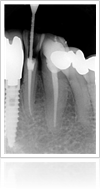When you visit your dental office in Bel Air, MD to receive treatment for a cavity, there are times when your dentist may recommend a root canal . Continue reading to learn more about this commonly performed dental procedure. 
Allowing Cavities to Progress
Cavities occur when bacteria cause damage to the surface of a tooth and begin to penetrate the enamel. When left untreated, a dental cavity can become severe enough that bacteria can make their way into the tooth. Once a tooth becomes infected, the tissues inside can become inflamed. The swelling can cause the individual a great deal of discomfort which is frequently what leads them to see a dentist for treatment. In addition to cavities, cracked and broken teeth can also be vulnerable to infection.
Examining the Tooth
Once a tooth is infected, parts of it can become damaged and, in some cases, the swelling prevents proper blood flow to the tooth which can kill the tissues inside. When you visit your dental office for a toothache, your dentist will examine your mouth, and he may also take X-rays of the painful tooth to get a better look at the extent of the damage. Depending on how big the cavity is or what damage the infection has caused, your dentist may tell you that you need a root canal.
Performing the Root Canal
Root canals are safe procedures that are frequently performed in dentistry, and they can provide patients with relief from the pain that they are experiencing while avoiding the need to extract the tooth. First, your dentist will numb the area. Next, he will drill a hole into the tooth to remove the infected tissues inside. Then, he will treat the infection, clean out the tooth, and fill the canal with a special type of tooth filling material. Finally, your dentist will use a filling or a crown to seal the tooth and restore its dental function. The site may feel tender for a few days, but patients usually feel much better following their root canal procedure and can enjoy restored function of their tooth.

